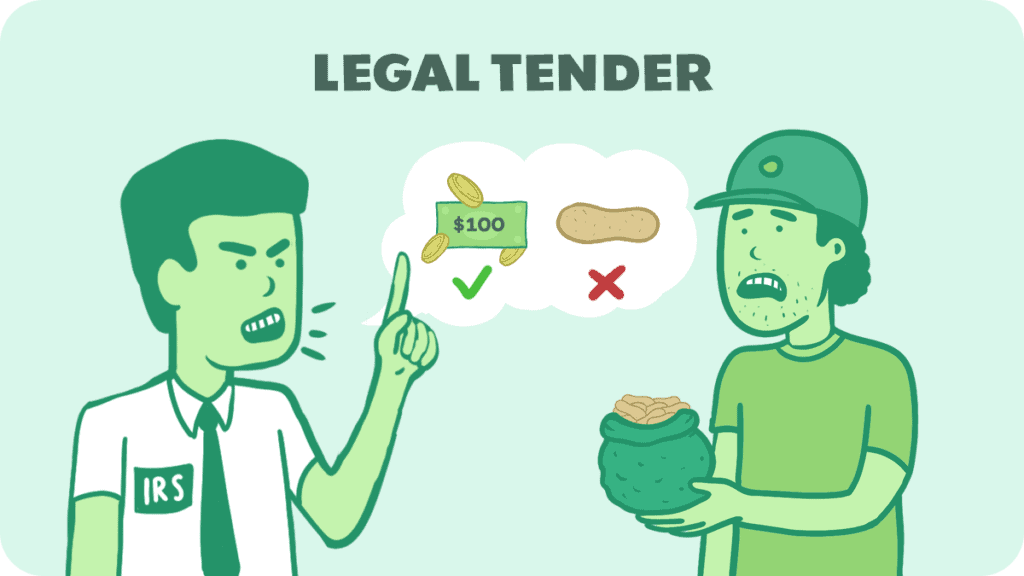Pretend I owe you a debt. Maybe I ran up a tab at your bar or maybe I’m paying you back for painting my roof. The debt comes due and I show up at your house with a bag (or truck, depending on the size of the debt) full of peanuts. Instead of paying you back with cash, I offer you an equivalent amount of peanuts as payment for my debt. Would you accept?
If you’re an elephant, you might. Otherwise, you might demand I pay my debt with US dollars. If I were to refuse, we might end up in court. When we go before the judge, I patiently explain that I have already paid my debt by offering the amount in peanuts.
You refused to accept. Is the judge likely to side with me and view the debt as paid? No. You are not required by law to accept the peanuts as payment for our debt.

Let’s flip the script. This time, you are an elephant and when I offer you a cash sum of what I owe you, you demand peanuts. Again, if I agree, there’s no problem and the debt is paid, but what if I refuse? I offer you US dollars and, again, you refuse to accept it and we end up in court.
I explain to the judge that I have already paid the debt by tendering (which is just a fancy term for offering) you the amount in cash. This time, the judge rules the debt has been absolved and I have met my legal obligations.
What’s the difference between the two situations? After all, the value of the peanuts offered in the first scenario and the cash in the second are the same. Why does one satisfy the debt while the other does not?
The simple answer is that, in the second scenario, the cash offered as repayment is legal tender. Unsurprisingly, peanuts are not considered legal tender. In this article, we will explore what legal tender is and why it’s important.
What is Legal Tender?
Legal tender is anything that is recognized by law as an acceptable means of settling a public or private debt. In other words, if you owe someone money, legal tender is something you can offer to repay the debt.
The courts will accept this as absolving the debt. Note that this only applies to debts incurred; sellers are not obligated to accept legal tender for purchases except where the law specifically requires it.
Additionally, the creditor is not necessarily obligated to accept the payment; however, the act of the debtor tendering—or offering—the legal tender absolves the debt in the eyes of the law.
The national currency is considered legal tender in practically every country. In addition to debts, legal tender is automatically accepted as payment for other financial obligations, such as taxes, legal fines, and damages.
The legal tender also serves as the legally recognized money within a jurisdiction, serving the three functions of money: a means of exchange, a unit of account, and a store of value.
Although the establishment of a legal tender does not automatically exclude other things from being used as money, the legal tender effectively becomes the primary form of money in a given jurisdiction.
Why Have Legal Tender?
Legally, the primary purpose of legal tender is to determine what courts will view as acceptable forms of payment to satisfy a debt. It also tells debtors what can be used to satisfy their debts.
Economically, it is to determine by statute what is to be used as a common currency, thus allowing the economy to function. In addition to determining what is to be used as legal tender, legal tender statutes generally specify the institution that is authorized to produce the legal tender and issue it to the public.
In modern economies, this more often than not takes the form of the nation’s fiat currency and the institution is often the nation’s central bank.
Economic Functions of Legal Tender
Establishing a legal tender has several economic benefits. First of all, having a single currency can eliminate the transaction costs associated with using multiple, competing currencies.
For example, if you wanted to buy something with Currency A, but the store you were shopping at only used Currency B, you would have to find some way to exchange currencies before the transaction could occur. Establishing by law a single, acceptable currency (or a limited number of currencies—more on that later) helps you avoid these complications.
Additionally, since the legal currency is often the national currency, this allows monetary policy to be conducted. Legal tender laws often establish the sole authority to issue the legal tender—more often than not, it is a central bank.
Since this authority is the only one legally allowed to issue money, it has exclusive control of the money supply. This allows it to control things like interest rates and use this manipulation to manage the economy by attempting to keep both inflation and unemployment rates low.
Finally, it allows the sole issuers (again, generally a government entity) to profit through the concept of seignorage. As we mentioned earlier, legal tender in modern times usually takes the form of fiat money. That means it’s not backed by anything other than the government and, therefore, cheap to produce since the government is literally printing money and saying it’s worth something.
For example, if the US government produces a $1 bill at the cost of $0.01, then it has made $0.99 on the transaction. This represents a form of revenue for governments to take advantage of.
Who Decides What is Legal Tender?

Basically, each government decides what is or is not legal tender in their jurisdiction. The government of Brazil determines what is legal tender in Brazil and the government of China determines what is legal tender in China. However, there can be some complications and overlaps that are worth exploring.
First is the role of international agreements and supranational structures, most notably, the European Union. By agreement, governments of the European Union surrender their right to determine their own legal tender and accept a common currency, namely, the euro.
Within the euro area, the euro is the single legal tender. Countries subscribing to the euro cannot establish their own form of currency or a different type of legal tender.
The exception to the rule is Denmark, which does not participate due to an ‘opt-out’ (as did the UK prior to their complete exit from the EU), and other European Union countries that have not yet met the convergence requirements to convert their currencies to the euro.
Convergence requirements are make sure that if a state transfers over to the euro completely, it won’t cause economic risk to the state itself or the rest of the euro-users. This usually includes things like price stability and long-term interest rates.
Second is the federalist system of the United States. In the US, there are two sovereigns: the federal government and the state governments. Though they often have separate and distinct powers, the ability to set legal tender is a concurrent power meaning that it can be exercised by both the federal or state governments.
The federal government has established US coins and currency as legal tender; thus, they are accepted as legal tender in all fifty states. However, states can establish additional forms of legal tender. Some states also accept gold and silver as legal tender, including:
- Texas
- Louisiana
- Utah
- West Virginia
- Oklahoma
- South Carolina
Examples of Legal Tender

Probably the two most notable examples of legal tender are the US dollar and the euro. However, these are not the only examples of legal tender, and others are worth discussing to highlight some of the points we’ve made throughout the article.
First off, though states can accept things other than US currency—namely, gold and silver—as legal tender, it should be noted that the US Constitution prohibits states from printing their own money. They can accept things other than federal money as legal tender if they already exist, but they cannot make their own.
Additionally, there is nothing to prevent a country from accepting the currency of another country as legal tender.
Some currencies, such as the US dollar and euro, are accepted as legal tender in countries that either do not print their own money or have found the stability of these larger currencies preferable to their own.
One example is Ecuador in 2000. Following the rapid depreciation of their own currency, Ecuador decided to accept the US dollar as legal tender.
Finally, the emergence of cryptocurrency provides an interesting development for legal tender. Though in 2021 El Salvador became the first country to accept Bitcoin as legal tender, the US, the EU, and most other countries do not accept cryptocurrencies as legal tender.
Nevertheless, given the growing popularity of online and cross-border transactions, there is an increasing demand for this to change, and some countries have experimented with electronic currencies.
In 2018, Venezuela’s President Madura ordered an online currency, the petro (which is based on Venezuela’s estimate of its oil reserves), to be accepted as legal currency.
Additionally, the Marshall Islands has announced that it will adopt a new cryptocurrency—the sovereign—to be accepted as legal tender alongside the US dollar.
Conclusion
If you have ever looked at the writing on a dollar bill declaring it “legal tender for all debts public and private” and wondered what exactly that meant, we hope this article helped clarify things. Thanks for reading, and please join us again for more informative articles.

